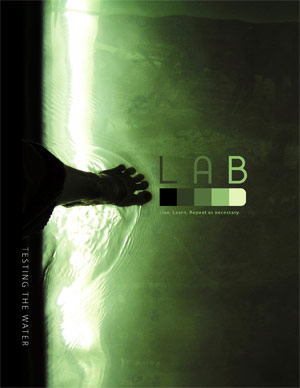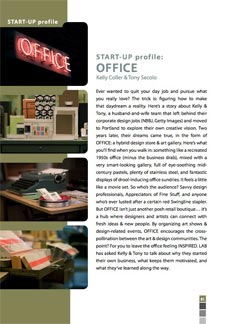Ever wanted to quit your day job and pursue what you really love? The trick is: figuring how to make that daydream a reality. Here’s a story about Kelly & Tony, a husband-and-wife team that left behind their corporate design jobs (NBBJ, Getty Images) and moved to Portland to explore their own creative vision. Two years later, their dreams came true, in the form of OFFICE: a hybrid design store & art gallery. Here’s what you’ll find when you walk in: something like a recreated 1950s office (minus the business drab), mixed with a very smart-looking gallery, full of eye-soothing mid-century pastels, plenty of stainless steel, and fantastic displays of drool-inducing office sundries. It feels a little like a movie set. So who’s the audience? Savvy design professionals, Appreciators of Fine Stuff, and anyone who’s ever lusted after a certain red Swingline stapler. But OFFICE isn’t just another posh retail boutique… it’s a hub where designers and artists can connect with fresh ideas & new people. By organizing art shows & design-related events, OFFICE encourages the cross-pollination between the art & design communities. The point? For you to leave the office feeling INSPIRED. LAB has asked Kelly & Tony to talk about why they started their own business, what keeps them motivated, and what they’ve learned along the way.
THE STORY
As design professionals, Tony and I were always looking for the perfect laptop case or portfolio bag. Presentation covers, unique binders, art paper, design books— we hunted these down for our design colleagues and clients. Having searched for the perfect boutique, we realized that we had not seen a place like the one we envisioned, so, in short, we decided to just create it. We put everything that we loved under one roof. One-stop-shopping, as they say. We also knew that Portland would be the perfect place for an unusual boutique to flourish— shoppers are committed to buying local and supporting indie business. The creative community was really amazing— and not being served as well as we thought it could be.
THE STYLE
Simply put, OFFICE’s aesthetic is what Tony refers to as “blue-collar mid-century modern,” where form meets function. In other words, affordable good design without pretense. That’s what OFFICE is all about. Our style references the past while remaining grounded in the present. The look is raw and refined, vintage and modern, stylish but unpretentious. Which is why when you walk into OFFICE, you’ll find a1950’s office as the backdrop for our products. We don’t sell vintage— yet.
THE INSPIRATION
Inspiration came from our obsession with everyday office objects, stellar stationary, neon signage, and the overall design sensibility of the 40’s and 50’s, combined with their modern counterparts. We were also heavily influenced by the design movement on the West Coast between the 30’s and 50’s that celebrated all design disciplines— the belief that design was for everyone, and should be accessible and affordable. This movement also believed that design had the power to help society move forward, to change and unite people… a belief we share. We are fascinated with all of the old Arts + Architecture magazines. We are inspired by everything from vintage stores to great little underground art galleries; the Jack Spade store in NY; Peter Miller’s bookstore in Seattle, and Portland’s down-to-earth, “snob-free” business community.
THE START-UP
Moving from concept to reality is no small challenge. Once we refined the concept of OFFICE and tested it in a few small circles, we wrote a very detailed business plan, bought the book Small Businesses for Dummies, accepted what we didn’t know (and found experts who did), set up an LLC with a great legal team, focused intently on connecting with the local press (there’s no such thing as too many press releases), and worked hard to engage our core customers in a constant dialogue. We openly share our resources— printers, designers, fabricators, you name it. No elitist secrets here.
FINANCING
Financing was rough. We interviewed a lot of small businesses on how they raised capital; we also interviewed several banks, and the SBA. We came to the conclusion that the fastest and easiest way to get start-up funding was to do it ourselves. We sought out friends with MBAs and walked through different scenarios. Eventually, we did it with bootstrap funding: a combination of credit cards, lines of credit, savings, home equity, and a loan from Tony’s parents that in the end resulted in about $200,000 start-up funds. A year after opening, with a proven history, good credit, and amazing publicity, we refinanced everything with a great community bank (Bank of Tigard), which allowed us to get out of debt and streamline all of our payments. The fact that we had been profitable since we opened helped quite a bit, so the bank knew that our business was succeeding and would continue to grow.
Part of our financial plan (and risk) was that for the first year, we would both commit to OFFICE all the way— 24/7. As part of our plan to ensure continued financial success of OFFICE, I returned back to the design world part-time, as the marketing director for a design firm that focuses on retail and graphic design called— oddly enough— Twenty Four Seven (www.twentyfour7.com). Which, of course, speaks to the fact that inspiration doesn’t punch a time clock, and good ideas happen beyond the 9-to-5 window.
DAY TO DAY
On a day-to-day basis, especially from Tony’s point of view, nothing beats designing or answering to yourself. He wouldn’t trade in his “job” to be a designer for a design firm anytime— although he still does graphic design for special projects. We feel lucky and fortunate that OFFICE has been embraced by the design and art community.
Every day, we get excited about hearing from our customers and what they’re doing. We’ve helped customers make portfolios and get design jobs; we provide resources and ideas for their projects. And, in return, they introduce us to new and interesting people. We’re always excited about design events— it’s a chance for us to interact with our customers. There isn’t anything we wouldn’t do for them, whether it’s making hand deliveries on the day we are closed, or working out after-hours appointments, or sending ideas to the press on cool stuff that we think should get some ink.
Our next challenges: designing our own products. And search engine optimization for our website.
All in all, we love Portland and I think our excitement shows. ¤
Kelly Coller + Tony Secolo
PUTTING IT ALL TOGETHER TOP TAKE-AWAYS FROM OFFICE
do the math
We can’t emphasize enough the importance of doing a very detailed business plan that clearly outlines every element of your concept, including financial projections. This allows you to test your ideas and refine them before you go forward and plan for growth. Determine your unique point of view.
advisory board
Admit early on that you don’t know everything and seek out others with different yet complimentary specialties. For us, it was asking our MBA friend to help us with projections, financial reports, and troubleshooting.
partners
Seek out a partner very early on— even if in an advisory role. Starting your own business is really hard to do on your own. Also, Tony handles design and I handle marketing, which keeps our roles very separate. Additionally, seek out strategic alliances with companies that share the same or similar customer base.
funding
Go through the process of putting together what the SBA wants— but if time is of the essence, you can do it yourself with bootstrap funding if you have a good business plan.
website
Get your website up, even if it is only one page. This lets customers (and more importantly, the press) know who you are. Also, if you do online shopping, make it easy for your customers.
focus
Focus on your primary customer base; the others will follow. You can’t and don’t want to be all things to all people. Determine who your core customer base is and serve them above and beyond what they ask for.
advertising
Don’t spend your money on a variety of print ads— be focused, strategic and use alternative ways to get the word out. Advertising only works if your ads are there all of the time in the right publication. Focus your energy, in your first year, on sending out press releases.
press releases
If you can’t do it, ask a friend to help you with this in trade for something you offer. This is the key element to success, along with always thanking the press for the opportunity, even if you don’t get ink at first.
design
Every major magazine from Business Week to Fast Company has been talking about this topic for the past 5 years. Don’t skimp on your design. Create a seamless, consistent message for your customers in design and experience. Partner with a fantastic graphic designer early on. Again, trade if necessary.
criticism
Be open to criticism. It will only make your concept stronger in the beginning, and help your grow your business in the right direction. Keep an open mind, and talk to those who have been where you’re going.
Main text & Top Ten Take-Aways: Kelly Coller
Introduction & photos: Joseph Robertson



